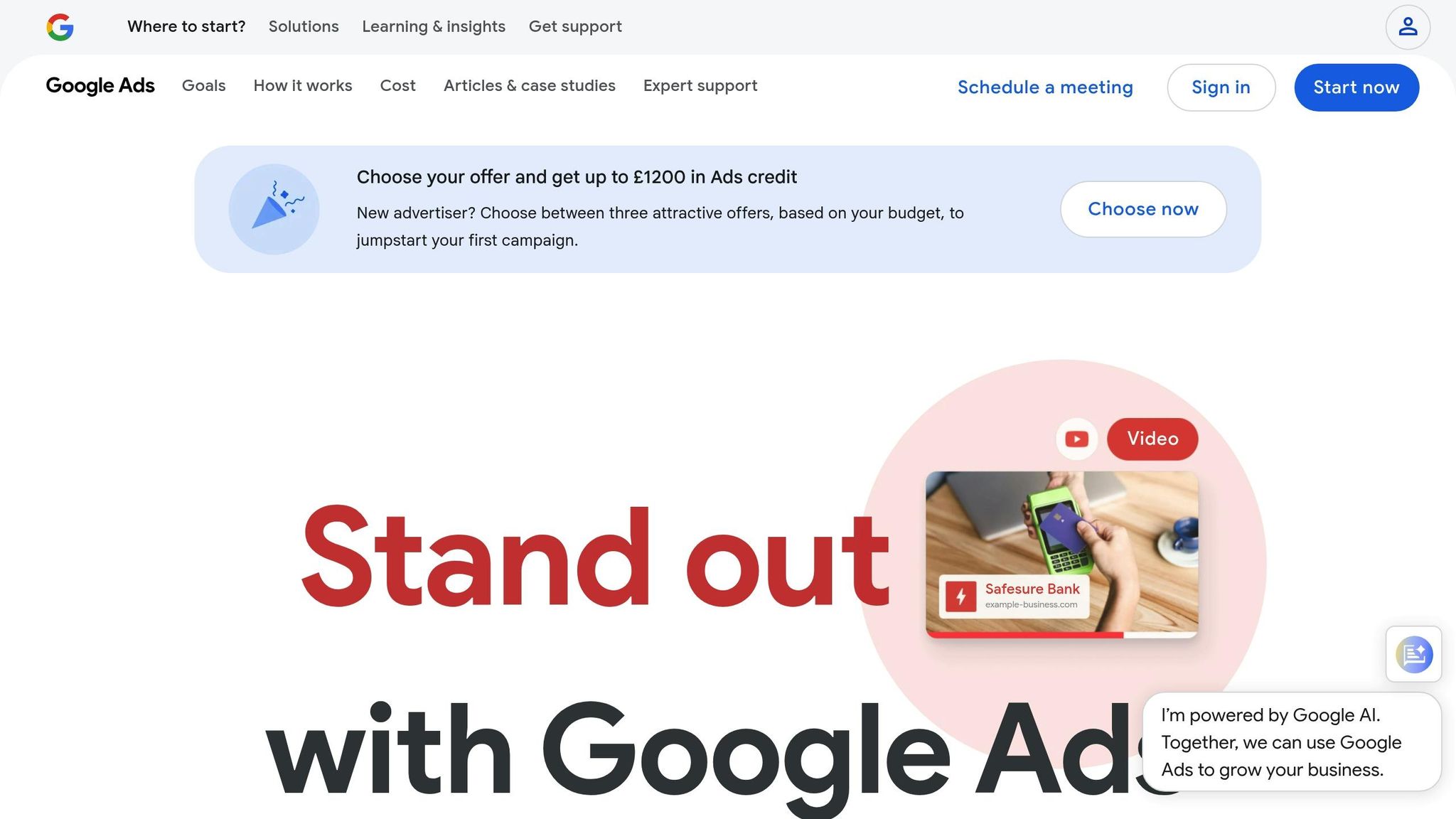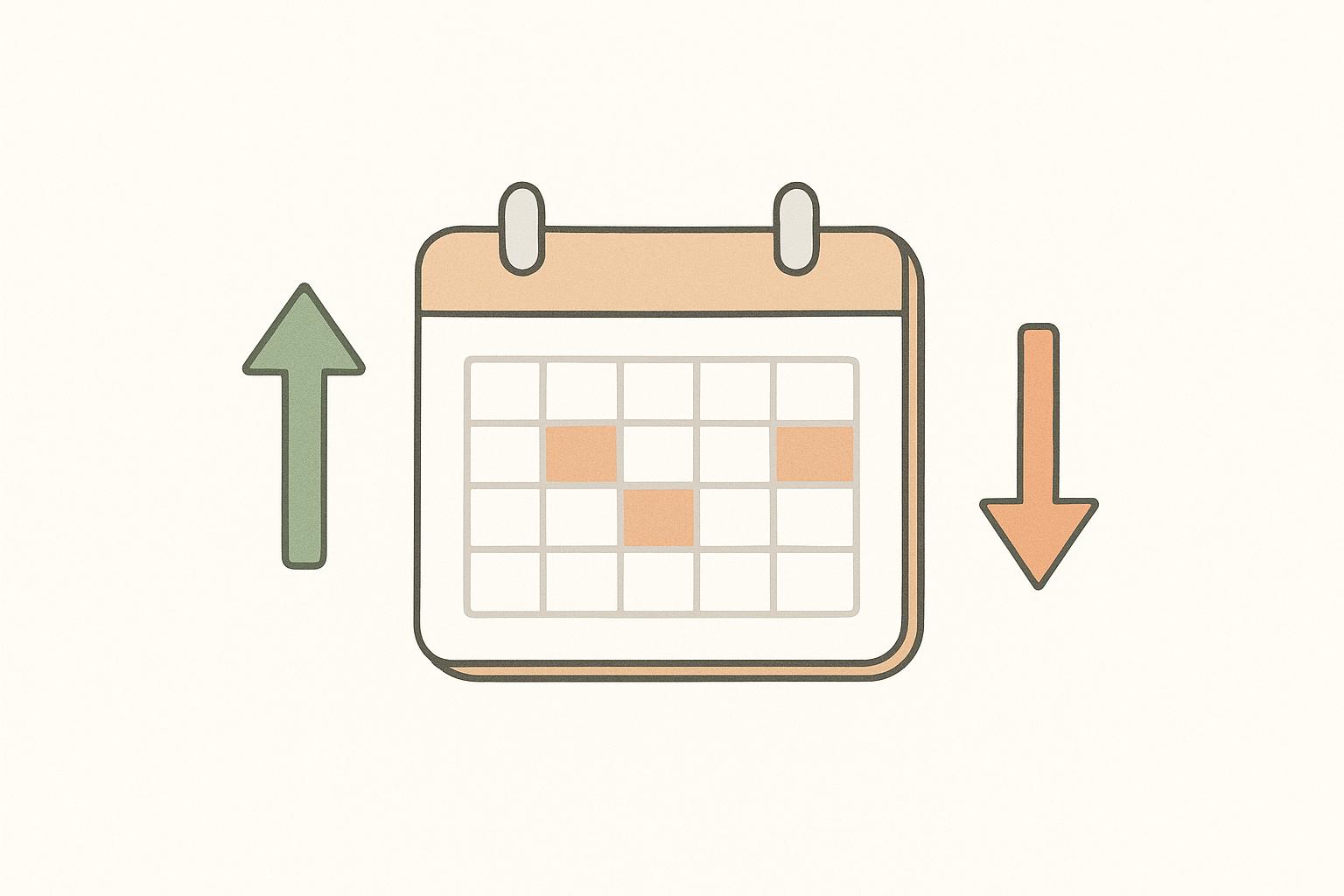Seasonality Bid Adjustments in Google Ads
Seasonality bid adjustments in Google Ads help you optimise campaigns for short-term events where conversion rates are expected to change significantly. They’re ideal for UK-specific events like Black Friday, Boxing Day sales, or Wimbledon, allowing you to adjust bids in advance and maximise results during these periods.
Key Takeaways:
- What it is: A tool to tweak Smart Bidding strategies for short-term conversion rate changes (1–7 days).
- Best for: Events like flash sales, holiday promotions, or UK-specific events (e.g., Black Friday).
- How it works: You set a percentage conversion rate adjustment, and Google adjusts bids automatically during the event.
- Supported campaigns: Search, Shopping, Display, and Performance Max (not Travel campaigns).
- Common mistakes: Overestimating conversion rate changes, applying adjustments for longer events, and neglecting budget constraints.
Quick Tips:
- Use historical data to estimate conversion rate changes.
- Start with modest adjustments (10–25%) and test over 48–72 hours.
- Automate start and end dates to avoid overspending.
- Monitor performance metrics like CTR, CPC, and ROAS daily.
Seasonality adjustments are a proactive way to align your ad strategy with short-term demand spikes. Use them wisely to capture peak opportunities without wasting your budget.
What Are Seasonality Bid Adjustments
Definition and Purpose
Seasonality bid adjustments let Google’s Smart Bidding anticipate short-term changes in conversion rates during specific events. By setting these adjustments in advance, you help the system respond more effectively to shifts in consumer behaviour without waiting for the algorithm to catch up.
"When you create a seasonality adjustment, you’re scheduling a conversion rate adjustment (an increase or a decrease), which accounts for estimated changes due to an upcoming event." – Google Ads Help
These adjustments are ideal for temporarily fine-tuning Smart Bidding strategies like Target CPA or Target ROAS when you expect a noticeable change in performance. For example, if you predict a 50% spike in conversion rates during a three-day sale, you can set an adjustment to reflect this change. This is particularly useful for events in the UK like Boxing Day sales or Wimbledon, where consumer behaviour tends to shift significantly.
By enabling these adjustments, Google’s algorithm can bid more aggressively during the event and automatically return to normal settings afterward. However, these adjustments are designed for exceptional events and not for regular seasonal trends.
Supported Campaign Types
Seasonality bid adjustments are compatible with several campaign types using Smart Bidding. They can be applied to Search, Shopping, and Display campaigns that use Target ROAS or Target CPA strategies. Performance Max campaigns support all bidding strategies, while App campaigns (currently in beta) also allow for these adjustments. However, Travel campaigns are not supported. While this tool is flexible, it comes with some important limitations.
Key Limitations
When using seasonality bid adjustments, there are a few critical factors to keep in mind:
- Duration: These adjustments work best for short-term events lasting 1 to 7 days. They are generally ineffective for events longer than 14 days.
- Conversion Rate Accuracy: Misjudging the conversion rate change can lead to inflated CPCs, potentially draining your budget too quickly.
- Real-Life Example: In 2019, SavvyRevenue worked with a large advertiser who set a seasonality adjustment for a 100% conversion rate increase based on the previous year’s Black Friday. However, the campaign’s budget was exhausted by 11:00 because the bids became excessively high. The actual CPC increase for that retailer was only 25%, meaning a 25% adjustment would have been more appropriate.
- Budget Issues: If your campaign is budget-constrained, Google’s algorithm might bid too aggressively early on, leaving no funds for the rest of the event.
- Algorithm Confidence: If historical data doesn’t fully support your projected conversion rate changes, the system may not adjust bids as aggressively as expected.
- Over-Reliance on Percentages: Basing adjustments solely on expected conversion rate increases, rather than realistic CPC changes, can unnecessarily inflate bids and waste budget.
When to Use Seasonality Adjustments
UK Events That Benefit from Adjustments
Seasonality adjustments are particularly effective for short-term events, and in the UK, there are plenty of opportunities to take advantage of them.
Take Black Friday and Cyber Monday, for example. These shopping events often see a surge in competition, with the cost per click rising by as much as 26%. Adjusting your bid strategies during these periods can help you stay competitive.
Another key period is the Boxing Day sales, where post-Christmas shopping trends create unique conversion opportunities for retailers. Similarly, summer sales in July and August are especially relevant for industries like fashion and outdoor products.
Other noteworthy events include the Wimbledon fortnight, which can be a goldmine for businesses tied to sports or hospitality, and the Edinburgh Festival in August, where entertainment, accommodation, and dining sectors often experience a significant spike in demand.
Here’s a quick look at seasonal trends across UK markets:
| Season | Typical Trends |
|---|---|
| Q4 (October – December) | Increased traffic and sales driven by events like Black Friday, Cyber Monday, and Christmas. |
| Q1 (January – March) | New Year promotions and post-holiday sales maintain momentum, though performance begins to taper off. |
| Spring & Summer | Sector-specific demand, such as gardening and outdoor products, tends to rise. |
| Back to School | Categories like stationery, clothing, and electronics see a boost in August–September. |
How to Analyse Conversion Rate Changes
Once you’ve identified key seasonal events, the next step is to dive into your performance data. Analysing historical trends is the backbone of effective seasonality adjustments. Tools like Google Ads and Google Analytics can provide a wealth of insights into how past events have influenced your campaigns.
Pay close attention to metrics like Cost Per Acquisition (CPA), Click-Through Rate (CTR), and Conversion Rate (CVR) during these periods. These figures will reveal how seasonal fluctuations impact your results. Building a campaign calendar that aligns with major sales events and product launches ensures you can make timely adjustments.
It’s worth noting that conversion trends can shift year by year. That’s why it’s essential to focus on recent data rather than relying solely on historical patterns. Tracking and documenting the outcomes of each seasonal campaign will also help refine your strategies and improve future predictions.
Mistakes to Avoid
To make the most of seasonality adjustments, steer clear of these common errors:
- Using adjustments for events longer than a week: These tools are best suited for short-term events lasting 1–7 days.
- “Set-it-and-forget-it” mindset: Seasonality adjustments require active monitoring and fine-tuning throughout the event.
- Overly aggressive bid increases: Starting with modest adjustments of 10–15% and testing over 48–72 hours can prevent budget exhaustion without sacrificing results.
- Neglecting automation: Set clear start and end dates for adjustments and automate bid reversion once the event ends.
- Ignoring campaign structure and ad copy: Seasonality tweaks alone won’t compensate for weak campaign fundamentals like poor landing pages or irrelevant ads.
- Applying uniform adjustments across campaigns: Each campaign has unique goals and audiences, so a one-size-fits-all approach can lead to missed opportunities.
- Skipping pre-adjustment analysis: Decisions based on assumptions rather than data can result in wasted spend. Always ground your strategy in concrete performance insights.
How to Set Up Seasonality Adjustments
Step-by-Step Setup Process
Seasonality adjustments let you prepare Smart Bidding for changes in conversion rates during special events like promotions or flash sales. Here’s how to set them up in Google Ads:
- Navigate to Tools > Budgets and Bidding > Adjustments.
- Click on Adjustments and select the Seasonal option.
- To create a new adjustment, click the plus button. Under "Adjustment type", choose Conversion rate, which is the default for seasonal events.
- Assign a clear, descriptive name to your adjustment. You can also add a description to make it easier to identify later. Then, set the event’s start and end dates, noting that these adjustments are most effective for short-term events lasting 1–7 days.
- In the scope section, specify which campaigns to apply the adjustment to. You can target all campaigns of a certain type, select individual campaigns, or (for App campaigns) narrow it down to specific ad groups. Be selective to avoid unnecessary changes to campaigns that won’t benefit.
- Input your estimated percentage change in conversion rate based on historical data.
- Once all details are in place, click Save, followed by Create seasonality adjustment.
These steps can be tailored further for UK campaigns by incorporating local practices.
UK-Specific Setup Tips
When fine-tuning seasonality adjustments for UK campaigns, accuracy is key, especially during major shopping events like Black Friday or Boxing Day sales.
- Start with modest adjustments, such as 10–25% of your base bid, rather than making drastic changes. Set up automated rules with clear spending limits in GBP (£).
- Use UK date formats (dd/mm/yyyy) when entering start and end dates. This avoids scheduling errors, such as setting Boxing Day adjustments for 12/26 instead of 26/12.
- Ensure your adjustments align with UK time zones – either GMT or BST, depending on the season. For instance, Black Friday deals often kick off at midnight UK time.
- Focus on campaigns with a history of strong performance during seasonal peaks. Set bid reversion dates 24–48 hours after the event ends to capture late shoppers while avoiding unnecessary high costs.
Once adjustments are live, keep a close eye on performance and make tweaks as needed for the best results.
Performance Review and Improvement
During high-traffic events, track key metrics like ROAS (Return on Ad Spend), CTR (Click-Through Rate), conversion rate, and CPC (Cost Per Click) daily. Comparing these figures against past performance can highlight areas for improvement.
Dig deeper into campaign performance to identify which segments or products are delivering the best results. Record data such as predicted versus actual conversion rates, budget usage, and any performance irregularities for future reference.
Customer behaviour patterns during these periods can offer valuable insights. Use this data to refine your strategy and adjust budgets dynamically based on real-time performance. Setting up alerts can help you act quickly if performance shifts unexpectedly, ensuring timely adjustments during short seasonal windows.
Testing and optimisation are ongoing processes. Each seasonal adjustment provides data that can help you refine future campaigns, ensuring better results and more effective strategies over time.
sbb-itb-dcae4ad
Seasonality Adjustments vs Other Bid Strategies
Comparison of Different Bid Strategies
Seasonality adjustments and other bid strategies each have their strengths, depending on the goals and circumstances of your campaign. Understanding how they differ can help you choose the most effective approach.
Google Ads describes seasonality adjustments as a way to prepare Smart Bidding for expected shifts in conversion rates. This method is particularly useful for predictable events in the UK, like Black Friday or Boxing Day sales, where consumer behaviour changes significantly. It’s a proactive measure that adjusts bidding strategies ahead of time, ensuring campaigns align with anticipated trends. Once the event ends, the adjustments automatically revert, allowing campaigns to return to their usual performance metrics.
On the other hand, automated bidding strategies, such as Target ROAS and Maximise Conversions, rely on machine learning to optimise bids continuously. These strategies use real-time signals – like device type, location, and audience lists – to adjust bids dynamically during each auction. The key difference lies in their approach: automated strategies adapt based on ongoing performance, while seasonality adjustments are pre-planned to handle short-term, predictable changes.
| Strategy Type | Best For | Duration | Learning Method |
|---|---|---|---|
| Seasonality Adjustments | Short-term events with predictable changes | 1–7 days | Pre-planned adjustments |
| Target ROAS | Long-term revenue growth | Ongoing | Continuous machine learning |
| Maximise Conversions | High-volume campaigns | Ongoing | Continuous machine learning |
| Manual CPC | Full control over bids | Ongoing | Manual adjustments |
| Device/Location Adjustments | Specific audience targeting | Ongoing | Static percentage changes |
Manual bidding strategies, while offering full control, require constant monitoring and are prone to errors during fast-changing events like flash sales. These errors can distort historical data, which Smart Bidding relies on for optimisation. In contrast, seasonality adjustments automatically reset after the event, avoiding the risk of prolonged overbidding or underbidding.
Standard bid adjustments, such as those for devices or locations, work well for steady, ongoing optimisation. However, they lack the precision needed for handling temporary spikes or drops in conversion rates. These adjustments are better suited for targeting specific audience segments rather than addressing short-term fluctuations.
Another advantage of seasonality adjustments is their flexibility. Google Ads supports layering multiple bid adjustments, allowing marketers to combine seasonality adjustments with other strategies for greater accuracy. For example, pairing these adjustments with budget increases can help manage the surge in traffic during peak shopping periods. This layered approach ensures campaigns remain responsive and effective, even during the busiest times.
When and How to Set Up Seasonality Bid Adjustments in Google Ads

Conclusion
Seasonality bid adjustments give UK advertisers a way to navigate predictable changes in consumer demand. The key to success lies in careful planning and using data to guide decisions, rather than making last-minute changes during peak times.
Start by digging into historical data. Look at performance over the past 12–24 months to spot trends in conversion rates, seasonal traffic surges, and cost variations. This analysis helps you determine when and by how much to adjust your bids.
Timing is everything, especially for UK-specific events. For peak shopping periods like Black Friday or Boxing Day, begin fine-tuning your bids 7–10 days in advance. Once the event passes, ease back your adjustments over the following 3–5 days.
Moderate increases – typically between 10–25% – tend to work better than drastic changes. Test your adjustments over 48–72 hours to gauge their impact before committing. Using automated rules can simplify the process and ensure your bids are managed efficiently. This cautious approach helps you stay competitive without overspending during critical periods.
Once the seasonal rush is over, take time to review your campaign’s performance. Examine metrics like conversion rates, average CPC, and impression share. Use these insights to refine your strategies for future campaigns. Combining seasonality adjustments with broader campaign tactics – such as compelling ad copy, well-optimised landing pages, and thoughtful budget planning – can further improve results. Keep an eye on KPIs like click-through rates, conversion rates, and return on ad spend to measure how effective your campaigns are.
For businesses looking to elevate their seasonal PPC efforts, The PPC Team offers expert audits and optimisation services. Their focus on conversion rate optimisation and strategic bid management can help uncover opportunities while avoiding costly mistakes.
Ultimately, success with seasonality adjustments comes down to consistent application of key principles: thorough planning, careful testing, ongoing monitoring, and a commitment to refining your approach based on reliable data. By sticking to these strategies, you can make the most of seasonal opportunities without wasting resources.
FAQs
How can I predict changes in conversion rates to set effective seasonality bid adjustments in Google Ads?
To anticipate changes in conversion rates for seasonal bid adjustments in Google Ads, start by examining historical data from similar past events, like previous sales or promotional campaigns. For instance, if you notice a 50% boost in conversions during a comparable period, this can serve as a useful indicator for future performance shifts.
With this information, you can implement a seasonality adjustment in your campaign, temporarily fine-tuning your bid strategy to match the expected changes in conversion rates. As you gather more data from these adjustments, analyse the results to improve your predictions, helping you achieve better accuracy and optimise your campaign outcomes over time.
What risks are associated with seasonality bid adjustments in Google Ads, and how can they be avoided?
Seasonality bid adjustments can be tricky if not applied with care. For example, overestimating short-term shifts in consumer behaviour could lead to inflated costs or diminished campaign results. Similarly, leaving these adjustments active for too long can harm your campaign’s performance since they work best for short-term events, typically lasting between 1 to 7 days.
To minimise these risks, reserve seasonality adjustments for predictable, time-sensitive events. Keep a close eye on your campaign’s performance and promptly remove adjustments if they aren’t delivering the desired outcomes. With thoughtful planning and consistent monitoring, you can ensure these adjustments stay effective and aligned with your objectives.
Why aren’t seasonality bid adjustments suitable for long-term campaigns, and what should I use instead?
Seasonality bid adjustments are a tool for managing temporary changes in conversion rates, like those caused by sales events or holiday seasons. These adjustments are best for short-term situations, typically lasting less than two weeks, as they are designed to address brief performance fluctuations rather than ongoing trends.
For campaigns that run over a longer period, it’s better to adjust budgets and bids manually or rely on automated bidding strategies. These approaches are better suited to handling consistent patterns, ensuring stable performance and aligning with your business objectives.

